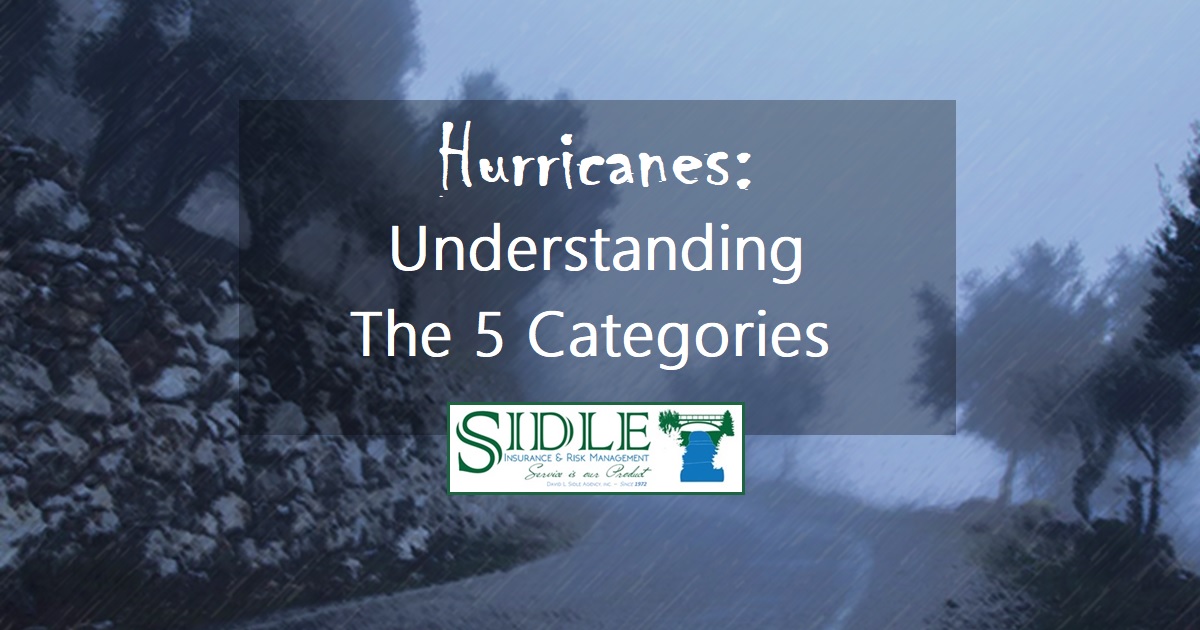The Atlantic hurricane season lasts every year from June 1 – November 30. That means we are now in the heart of it. If you find yourself hearing about tropical storms in the news soon, it might help to know a little bit about how they categorized – and what that means for the potential damage they can cause.

Hurricanes are rated via the Saffir-Simpson Hurricane Wind Scale.1 The scale measures hurricanes in 5 “categories” based on a given hurricane’s sustained wind speed. The scale details potential damage caused by a given storm, depending on its category.
The higher category a hurricane, the more dangerous the storm is likely to be.
Category 1 Hurricanes have a sustained wind speed of 74-95 mph.1 They are considered “very dangerous” and can have destructive effects, including some damage to roofs and other parts of the home. There is a potential that large tree branches may snap and trees with shallow roots fall. Power lines and electrical poles may be damaged and power outages could last several days.
Category 2 Hurricanes are those that have a wind speed of 96-110 mph.1 These winds are “extremely dangerous” and “cause extensive damage”. Homes can sustain major roof and siding damage in these storms. It is expected that many shallowly rooted trees will be downed/snapped in a Category 2 hurricane, potentially blocking roadways. Power loss could last from days to weeks.
While Category 1 and 2 hurricanes are considered dangerous and require preemptive action, hurricanes that are Category 3 or higher are regarded as “major hurricanes” due to their increased capability of causing significant damage and loss of life.1
Category 3 Hurricanes fall between 111-129 mph sustained wind speeds.1 “Devastating damage” will transpire amidst a Category 3 hurricane. Well-built framed homes can sustain major damage to parts of the home, including the roof. Blocked roads and structural damage will be caused by numerous snapped or uprooted trees. Both water and electricity will be unavailable for days to weeks following such a storm.
Category 4 Hurricanes have sustained winds of 130-156 mph.1 In the event of a Category 4, catastrophic damage will be inflicted. Homes will take severe damage and roofs/exterior walls will be mostly lost. Most trees and power poles will be downed, cutting off roads and isolating communities. Outages could last months and most of the area will be uninhabitable for weeks/months.
Category 5 Hurricanes are hurricanes with a wind speed of 157 mph or higher.1 Again, catastrophic damage is assured if a storm makes landfall as a Category 5. A high percentage of homes will be destroyed, including the collapse of roofs and walls. As with Category 4 storms, fallen trees, poles, and other debris will cut off residential areas with extended outages. The majority of the area will likely be uninhabitable for an extended period.
Only 4 recorded hurricanes have made landfall in the United States as a Category 5, the last being Hurricane Michael (2018).2
Hurricanes’ greatest hazard along coastal areas however may not be the winds, but something called “storm surge”.3
Storm surge is the abnormal rise of water above normal tide levels, caused by the forces of a storm. Storm surge can cause major flooding, especially at times when the surge corresponds with normal high tide.3
Although Hurricane Ike (2008) made landfall as a Category 2 hurricane in Texas, storm surges of as high as 20 feet above regular tide levels occurred, adding to the significant destruction the storm had already incurred.3
The amount of devastation that lower category hurricanes have left in their wake sometimes demonstrates that the Saffir-Simpson Hurricane Wind Scale may be a bit misleading, and ultimately, any hurricane can be dangerous and should be not be taken lightly.
In fact, infamous Hurricane Sandy (2012) struck the U.S. East Coast as a dissipated Category 1 storm, yet due to a mixture of circumstances, including an incredibly wide diameter, an unpredictable path, and a combination of other weather events, the ‘superstorm’ was the 4th costliest storm in U.S. history.4
Be sure to tune in for our next blog post, Hurricanes vs. Insurance.
1Saffir-Simpson Hurricane Wind Scale, https://www.nhc.noaa.gov/aboutsshws.php
2“Hurricane Michael Upgraded to a Category 5 at Time of U.S. Landfall.” Hurricane Michael Upgraded to a Category 5 at Time of U.S. Landfall |National Oceanic and Atmospheric Administration, https://www.noaa.gov/media-release/hurricane-michael-upgraded-to-category-5-at-time-of-us-landfall
3Storm Surge Overview, https://www.nhc.noaa.gov/surge/
4Gibbens, Sarah. “Hurricane Sandy, Explained.” Hurricane Sandy Facts and Information, 25 Feb. 2019, https://www.nationalgeographic.com/environment/natural-disasters/reference/hurricane-sandy/